DIESEL TRUCK FRONT END ALIGNMENT
&
FUEL ECONOMY
- GOALS:
- To understand that front end misalignment can result in tire wear and lower fuel economy.
- OBJECTIVE:
- The student will learn to properly identify abnormal tire wear and learn how different front end misalignment settings can result in premature wear problems and lower fuel economy.
- LESSON / INFORMATION:
- Have you ever wondered if there are any advantages to wheel alignment other than making tires last longer or reducing steering effort? These are the usual reasons to consider front tire/wheel alignment. First is tire wear. Tires are expensive on any vehicle, but for large, diesel powered rigs, prematurely worn out tires can add significantly to the operating cost. The second most important reason for aligning the front tires is to reduce steering drift, turning effort, and to improve the trackability of the truck. However, there is a third important reason to keep front tires in proper alignment: Fuel economy is affected by improperly aligned tires.
- A diesel powered truck is "pushed," that is, it is a rear wheel driven vehicle. The driving forces come from the rear of the truck. As the truck is pushed, the front tires have a certain amount of rolling friction between the tire surface and the roadway. This results in what is known as "drag." See illustration #1.
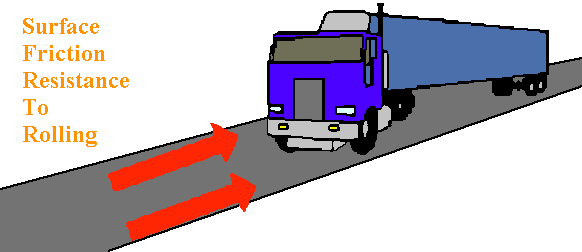
- Illustration 1
- As the vehicle rolls forward, the drag causes the tires to want to move outwardly. This outward motion is a result of the normal-tolerance, steering-linkage free-play. Thus, when the vehicle is in a static (non-moving) state, the tires are "aligned" so that the front leading edges of the tires are closer together than the rear trailing tire edges. See illustration #2. This condition is known as a toe-in setting.
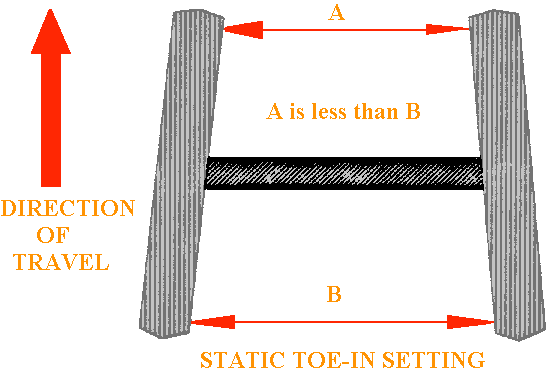
- Ilustration 2
- If the toe setting is improper - excessive or insufficient - the tires will not roll in a parallel fashion; thus, the road friction force will cause wear to the tire. As a result, energy will be lost since the tire fights the truck's intended path-of-travel. The lateral, side forces cause tire wear. We can see the result on the tires, but it is not always easy to see the result on fuel economy.
- Tires which are improperly toe-aligned can account for two increased operational expenses: (1). decreased tire life, and (2). decreased fuel economy. Tires out-of-toe adjustment by 1/8 inch will wear significantly faster. Depending on the size of the tire and load of the truck, tire life could be reduced as much as half. The effective use of fuel could be reduced from one or two tenths miles per gallon (MPG) or up to three or more tenths MPG. A typical 11:00 X 24.5, 10-ply, new front radial tire costs approximately $260.00. A misaligned front end that adds ten percent (10%) drag will decrease tire life by ten percent (10%). Only a slight misadjusted toe setting could cause a ten percent (10%) additional drag. If a typical over-the-road truck delivers six (6) MPG, 2/10 MPG represents a 3.33% increase in operational expense.
- For example, a truck which operates 50,000 miles per year and averages 6 MPG would have an annual fuel cost of $10,416.66 if diesel costs $1.25 per gallon. If the MPG were lowered to 5.8 due to improper alignment, then fuel cost would increase to $10,775.86 or by $359.20. A second front end misalignment that will increase tire wear and decrease fuel MPG is tire camber. Camber is the tilt of the tire in a vertical plane. If the tops of the tires are farther away from each other, then the tires are said to be aligned with positive camber. If the tops of the tires are closer together, the tires are said to have negative camber. See illustration 3.
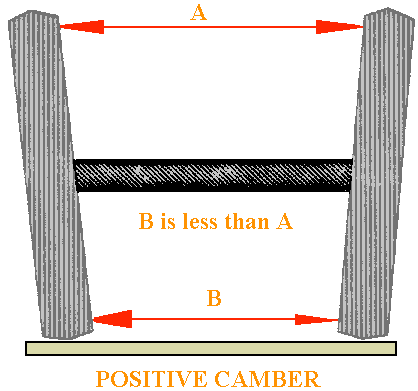
- Illustration 3
- Most large trucks use a very slight positive camber setting, usually less than 1°. Camber evenly distributes the truck's load across the two wheel bearings and assists in keeping the truck from drifting slightly when tracked in a straight line. Insufficient or excessive camber shifts the load to one edge of the tire resulting in excessive shoulder wear. See illustration #4.
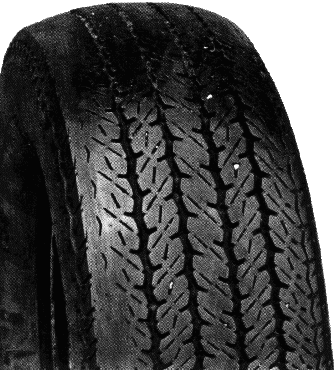
- Illustration #4, Courtesy of Moog Automotive, Inc.
- Excessive unequal camber will cause the truck to pull toward one side. To keep the truck on path, the driver will have to compensate by turning the wheel. The need for the slight off-center steering force to keep the truck in a straight line results in excessive drag and, subsequently, decreased MPG. Some manufacturers recommend a small camber difference to compensate for crowned roads. This difference is usually less than 1°.
- ACTIVITY:
- Study the illustrations below for typical tire wear problems. Notice how each wear pattern is different from each other. For example, excessive toe-in wear creates a "feathered" saw-tooth effect across the tread. Locate any truck larger than one ton and request permission to visually inspect the front tires for improper tread wear. Using the activity sheet provided, question the driver/owner about the ability of the truck to "track" in a straight line and ease to turn in both left and right directions. Compare the answers to the questions and the condition of the tires. Would you recommend that the driver have the alignment checked? Write a summary of your recommendation.
- A.
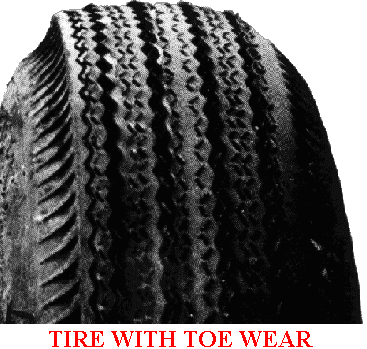
- B.
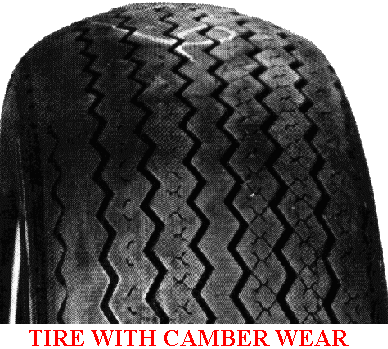
- C.
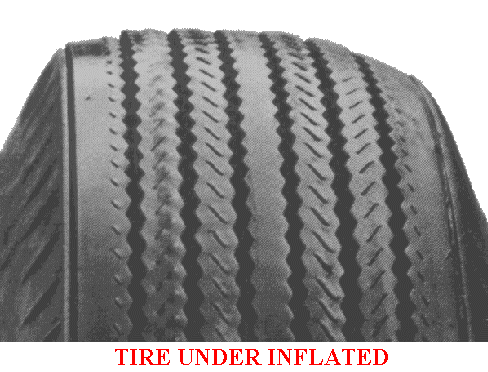
- D.
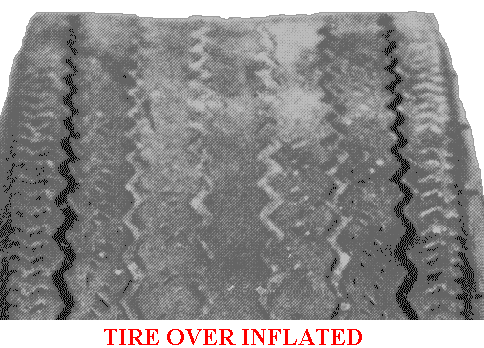
- Illustrations a-d, Courtesy of Moog Automotive, Inc.
- DIESEL MECHANICS VISUAL PRE-ALIGNMENT INSPECTION
- Student Name:_________________________ Date Activity Completed:___________
- Purpose:
- To determine if a front tire alignment is needed.
- Procedure:1.
- Locate a large truck (greater than one ton G.V.W.)
- Make/Model/Year/Size:____________________________________________
- Front Tire Make/Model/Year/Size:_________________________________
- 2. Request permission from the driver / owner to inspect the front tires.
- Permission Granted? ______ Yes ______ No
- 3. Using illustrations, visually inspect the two front tires.
- a. Signs of toe wear?
- Left: _____ Yes ______ No
- Right: ______ Yes _____ No
- b. Signs of camber wear?
- Left: _____ Yes ______ No
- Right: ______ Yes ______ No
- 4. Ask driver if the vehicle "pulls" to left or right.
- Pulls?: ______ Yes ______ No
- 5. Ask driver if the vehicle drifts when traveling in straight line.
- Drifts?: _____ Yes _____ No
- 6. Recommendation to driver / owner (complete this statement):
- Based on my interview and visual inspection, I recommend:
- ______________________________________________________________
- ______________________________________________________________
- for the following reasons:
- ______________________________________________________________
- ______________________________________________________________
- _____________________________________
- Signed / Date
- INFORMATION CHECK
- Place a "T" before the statements that are true and an "F" before the statements that are false. After each false statement, explain why it is false.
- _______1. Abnormal tire wear is the only reason to check and adjust the front alignment of a diesel powered heavy truck.
- ______ 2. The toe adjustment compensates for the difference in road crown.
- ______ 3. Tire drag is a rolling tire force that is normally created as a result of the friction forces between the tire and the roadway.
- ______ 4. Camber is the tilt of the tire in a vertical plane.
- ______ 5. A difference in the camber angle on one side or the other may cause the truck to pull to one side.
- TEACHER NOTES:
- As instructors, we often fail to acknowledge the secondary reasons to properly align large truck front ends. Not only will tires prematurely wear but improper alignment will cause the truck to burn extra fuel and be more difficult to drive. Small incremental decreases in tire life and fuel economy can add up over a long period of time. All students need to be aware of the potential increased operating cost and loss of profit.
- ANSWERS TO INFORMATION CHECK:
- 1. False. It is true that improper alignment will prematurely wear out the front tires but improper alignment will also cause a decrease in fuel economy. This is due to the increased drag or tire squirm and fight induced by the road to tire contact.
- 2. False. Toe adjustment compensates for normal steering and suspension lash or free play. Camber can be used to compensate for road crown.
- REFERENCES:
- Schultz, Erich J. Diesel Equipment II. Gregg Division of McGraw Hill, New York. 1982.
- Norman, Andrew, and Robert Scharff. Heavy Duty Truck Systems Electrical - Powertrain - Steering - Suspension Brake and Accessory Systems. Delmar Publishers Inc. 1991.
Comments or questions to: TechAsmt@LA.GOV
Return to Diesel Menu











